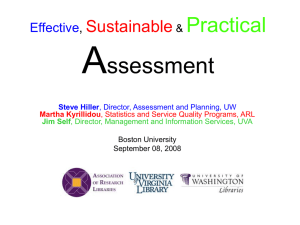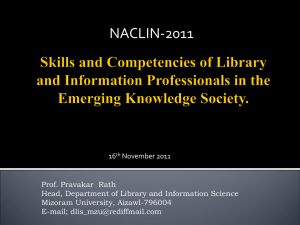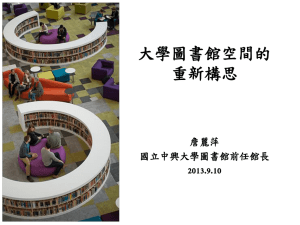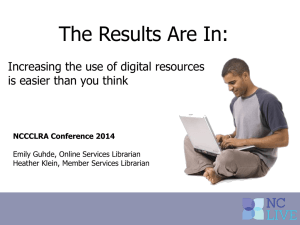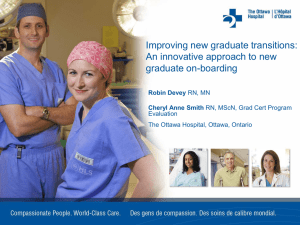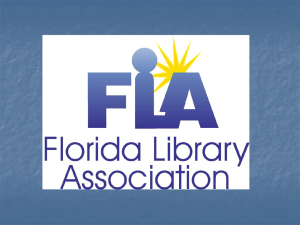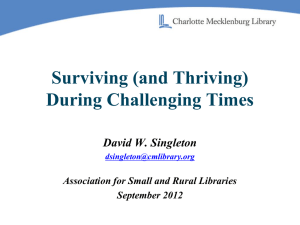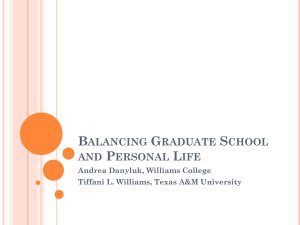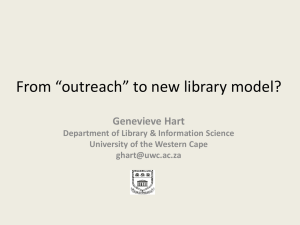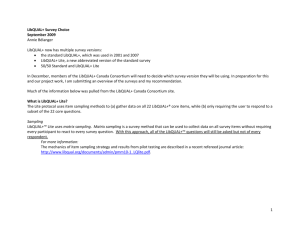Powerpoint slides from Opening Session
advertisement
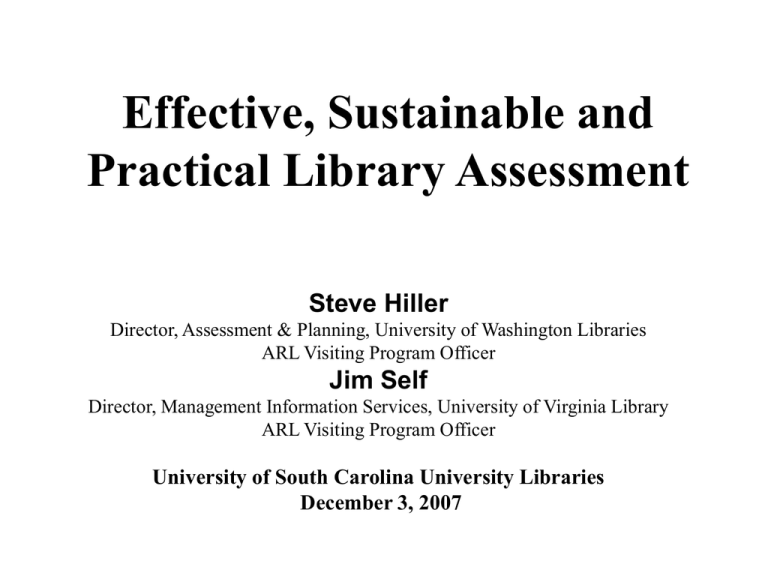
Effective, Sustainable and Practical Library Assessment Steve Hiller Director, Assessment & Planning, University of Washington Libraries ARL Visiting Program Officer Jim Self Director, Management Information Services, University of Virginia Library ARL Visiting Program Officer University of South Carolina University Libraries December 3, 2007 Library Assessment More than Numbers Library assessment is a structured process: • To learn about our communities • To respond to the needs of our users • To improve our programs and services • To support the goals of the communities Why Assess? • • • • • • • Accountability and justification Improvement of services Comparisons with others Identification of changing patterns Marketing and promotion Opportunity to tell our own story Using data, not assumptions, to make decisions – Assumicide! The Challenge for Libraries • Traditional statistics are no longer sufficient – – – – Emphasize inputs – how big and how many Do not tell the library’s story May not align with organizational goals and plans Do not measure service quality • Need measurements from the user’s perspective • Need the organizational culture and the skills to answer a basic question: What difference do we make to our communities? ARL Sponsored Assessment • Tools – ARL Statistics – LibQUAL+® – MINES for Libraries • Building a Community of Practice – – – – Library Assessment Conferences Service Quality Evaluation Academy Library Assessment blog Workshops Individual Library Consultation (Jim and Steve) – Making Library Assessment Work (24 libraries in 2005-06) – Effective, Sustainable, Practical Library Assessment (6 in 2007) What We Found in Our Visits • Strong interest in using assessment to improve customer service and demonstrate value • Uncertainty on how to establish and sustain assessment • Lack of assessment knowledge among staff • More data collection than data utilization • Effectiveness not dependent on library size or budget • Each library has a unique culture and mission Effective Assessment • • • • • • • • Focuses on the customer Is aligned with library and university goals Assesses what is important Is outcomes oriented Develops criteria for success Uses appropriate and multiple assessment methods Uses corroboration from other sources Provides results that can be used Sustainable Assessment Needs . . • • • • • • • Organizational leadership Sufficient resources Supportive organizational culture Identifiable organizational responsibility Connection to strategic planning and priorities Iterative process of data collection, analysis, and use Involvement of customers, staff and stakeholders Practical Assessment • • • • • Keep it simple and focused – “less is more” Know when enough is enough Use assessment that adds value for customers Present results that are understandable Organize to act on results Customer-Centered Library and the Culture of Assessment Customer-Centered Library Culture of Assessment • All services and activities are viewed through the eyes of the customers • Customers determine quality • Library services and resources add value to the customer • Organizational environment in which decisions are based on facts, research and analysis, • Services are planned and delivered to maximize positive customer outcomes It’s not about us! It’s about the customer. Understanding our Customers: What We Need to Know to Support Our Communities • • • • • • What are their teaching, learning, and research interests? How do they work? What’s important to them? How do they find information needed for their work? How do they currently use library/information services? How would they prefer to do so? How do they differ from each other in library use/needs? How does the library add value to their work? How does the library contribute to their success? If It Was Only This Easy! Good Assessment Starts Before You Begin . . . Some Questions to Ask • Define the question – What do you need to know and why • How will you use the information/results • Where/how will you get the information – Methods used – Existing data – New data (where or who will you get it from) • How will you analyze the information • Who will act upon the findings University of Washington (Site of the 2008 Library Assessment Conference!) • Located in beautiful Seattle metro population 3.2 million • Comprehensive public research university – 27,000 undergraduate students – 12,000 graduate and professional students (80 doctoral programs) – 4,000 research and teaching faculty • $800 million annually in federal research funds (2nd in U.S.) • Large research library system – $40 million annual budget – 150 librarians on 3 campuses University of Washington Libraries Assessment Methods Used • Large scale user surveys every 3 years (“triennial survey”): 1992, 1995, 1998, 2001, 2004, 2007 • In-library use surveys every 3 years beginning 1993 • Focus groups/Interviews (annually since 1998) • Observation (guided and non-obtrusive) • Usability • Usage statistics/data mining Information about assessment program available at: http://www.lib.washington.edu/assessment/ Case Study: UW Libraries Review of Support of Bioscience Programs Reasons for review • Better understand how bioscientists work • Understand significance and value of bioscience and research enterprise to University • Gauge extent and impact of interdisciplinary research • Understand implications of changes in library use patterns • Review viability of Libraries organizational structure/footprint • Strengthen library connection in support of bioscience programs and the research enterprise The Importance of the Research Enterprise University of Washington Operating Revenues $2.4 Billion in 2005-06 Other 4% Gifts 9% Research Grants 43% Investment Income 13% State Appropriation 15% Tuition 16% Research Grants $1 Billion Health and Human Services $510 million National Science Foundation $95 million Other federal agencies $190 million Industry/Foundations $100 million Other non-federal $110 million More Than Surveys and Statistics The Qualitative Often Provides the Key • Increased use and importance of such qualitative methods as, comments, interviews, focus groups, usability, observation • Statistical data often can’t tell us – Who, how, why – Value, impact, outcomes • Qualitative provides information directly from users – Their language – Their issues – Their work • Qualitative provides context and understanding Biosciences Review Process (2006) • Define scope (e.g. what is “bioscience”?) • Identify and mine existing data sources – Extensive library assessment data • Including usage information – Institutional and external data • Including bibliometric information • Acquire new information through a customercentered qualitative approach – – – – Environmental scan Interviews (12 faculty) Focus groups (6 total – 3 faculty, 2 grad, 1 undergrad) Peer library surveys • NO NEW USER SURVEYS Faculty Interview Key Findings • • • • • • • First stop: Google or Pub Med Central; also WOS Those with grant support tend to buy books from Amazon The transaction costs from discovery to delivery is too high Need to integrate fragmented library systems and processes Graduate students are self-sufficient in finding information Faculty who teach undergraduates use libraries differently Had difficulty coming up with “new services” unprompted Focus Group Themes • Content is primary link to the library – Identify library with ejournals; want more titles & backfiles • Print is dead, really dead – If not online want it delivered online • Provide library-related services and resources in our space not yours – Discovery begins outside of library space with Google and Pub Med; lesser use of library bibliographic data bases – Faculty/many grads go to physical library as last resort; too many physical libraries • Lack understanding of many library services and resources Biosciences Task Force Recommendations • Integrate search/discovery tools into users workflow • Expand/improve information/service delivery options • Make physical libraries more inviting/easier to use – Consolidate libraries, collections and service points – Reduce print holdings; focus on services and work space • • • • Use an integrated approach to collection allocations Get librarians to work outside library space Lead/partner in scholarly communications and E-science Provide more targeted communication and marketing In God We Trust: All Others Must Bring Data Did themes raised in the interviews/focus groups reflect the bioscience population? The campus community? The 2007 Triennial Survey as corroborating source Related Questions Mode of access (in-person, remote) Resource type importance Sources consulted for research Primary reasons for using Libraries Web sites Libraries contribution to work and academic success Useful library services (new and/or expanded) UW Triennial Library Survey Number of Respondents and Response Rate 1992-2007 2007 2004 2001 1998 1995 1992 Faculty 1455 36% 1560 40% 1345 36% 1503 40% 1359 31% 1108 28% Grad Student 580 33% 627 40% 597 40% 457 46% 409 41% 560 56% Undergrad 467 20% 502 25% 497 25% 787 39% 463 23% 407 41% Mode of Library Use by Group 2007 (weekly or more often) Undergrad Remote & Visit 39% Visit Only 27% Grad Visit Only 2% Faculty Visit Only 1% Remote & Visit 19% Remote Only 14% Remote & Visit 45% Remote Only 47% Remote Only 72% Non- Weekly 20% Non- Weekly 6% Non- Weekly 8% Library as Place Change In Frequency of In-Person Visits 1998-2007 (weekly+) 80% Grad 70% Undergrad Undergrad 60% 50% Grad Faculty 40% 30% Faculty 20% 1998 2001 2004 2007 Change in Off-Campus Remote Use 1998-2007 (Percentage using library services/collections at least 2x week) 70% 70% Grad 60% 60% 50% 50% Faculty 40% 40% 30% 30% 20% Undergrad 20% 10% 10% 0% 0% 1998 2001 2004 2007 Graduate Student Mode of Access by Academic Area(% Using at least 2x week) 80% Visit In Person Connect from Campus Connect Off-Campus 70% 60% 50% 40% 30% 20% 10% 0% Health Sciences BioSciences Phys Sci-Engineering Hum-Soc Sciences Where Do they Go? Sources Consulted for Information on Research Topics ( Scale of 1 “Not at All” to 5 “Usually”) Undergrad Open Internet Search Grad Faculty Open Internet Ref Source Bibliographic Databases 2.5 2.75 3 3.25 3.5 3.75 4 4.25 4.5 “If it’s not on the Internet, it doesn’t exist.” My students at all levels behave this way. They also all rely on Wikipedia almost exclusively for basic information. Associate Professor, English Faculty: Resource Type Importance by Academic Area (Scale of 1 “not important” to 5 “very important”) 5 Journals>1985 4.5 4 3.5 3 2.5 Health Sciences Books BioSci Journals<1985 Phy Sci-Engin Bib Databases Hum-Soc Science Journals>1985 Reasons for Faculty Use of Libraries Web Sites by Academic Area (Use at least 2x per week) 75% 65% 55% 45% 35% 25% 15% Health Sci BioSci Library Catalog Phy Sci-Engin Bib Database Hum-Soc Sci Online journal articles Usefulness of New/Expanded Services for Faculty & Grads Scan on Demand Digitize specialized collections Office Delivery of Books Grad Faculty Integrate services into campus Web sites Manage your info and data 0% 10% 20% 30% 40% 50% 60% 70% 80% Libraries Contribution to: ( Scale of 1 “Minor” to 5 “Major”) Being a more productive researcher Keeping current in your field Finding info in new or related areas Efficient Use of Time Grad Faculty Academic Success 3 3.25 3.5 3.75 4 4.25 4.5 4.75 Survey Follow-Up Actions • Probe deeper on specific library contributions to research and student academic success using qualitative methods – Interviews/focus groups beginning Winter 2008 – Review scope and effectiveness of information literacy programs • Develop plan to deliver “print” content to faculty & grad students in their format of choice and in their space – Pilot test “scan on demand” begins January 2008 • Strengthen our subject librarian liaison efforts to better understand and support research in their areas – Develop standardized toolkit for assessing library connection to research enterprise. Revisit scholarly communications policy • Integrate library services & resources into user workflows How UW Libraries Has Used Assessment • • • • • • • • • Extend hours in Undergraduate Library (24/5.5) Create more diversified student learning spaces Eliminate print copies of journals Enhance usability of discovery tools and website Provide standardized service training for all staff Stop activities that do not add value Change/reallocate budgets and staffing Inform the strategic planning process Support budget requests to University How Are We Doing? Overall Satisfaction by Group 1995-2007 4.6 4.6 Faculty 4.56 4.5 4.4 4.33 4.3 4.5 4.44 4.33 4.34 Faculty 4.25 4.26 4.32 4.4 Grad 4.36 UW Seattle UG 4.3 4.36 4.2 4.1 4.2 Grad 4.18 4.11 4.22 4.1 4 3.9 4 Undergrad 3.97 3.99 3.9 3.8 3.8 1995 1998 2001 2004 2007 You guys and gals rock!!!!!! We need to invest in our library system to keep it the best system in America. The tops! My reputation is in large part due to you. Professor, Forest Resources UVA MIS Consult Collecting the Data at U.Va. • • • • • Customer Surveys Staff Surveys Mining Existing Records Comparisons with peers Qualitative techniques Corroboration • Data are more credible if they are supported by other information • John Le Carre’s two proofs UVa Customer Surveys • Faculty – 1993, 1996, 2000, 2004 – Separate analysis for each academic unit – Response rates 59% to 70% • Students – – – – 1994, 1998, 2001, 2005 Separate analysis for grads and undergrads Undergrad response rates 43% to 50% Grad response rates 54% to 63% LibQUAL+™ in 2006 Analyzing U.Va. Survey Results • Two Scores for Resources, Services, Facilities – Satisfaction = Mean Rating (1 to 5) – Visibility = Percentage Answering the Question • Permits comparison over time and among groups • Identifies areas that need more attention Reference Activity and Visibility in Student Surveys 7,000 6,008 Reference Questions Recorded per Week in Annual Sample 64% Visibility 39% Visibility 34% Visibility Reference Visibility among Undergraduate 75% Visibililty 1,756 10% 1,000 1993 1994 1995 1996 1997 1998 1999 2000 2001 2002 2003 2004 Making the most of LibQUAL • • • • • • • Scan the results by user category Use thermometer charts Identify high and low desire areas Identify the ‘red zones’ Examine the comments Compare satisfaction scores with peers Follow up on problem areas LibQUAL+ 2006 University of Virginia Faculty 9.00 8.00 7.00 6.00 Top of Blue Bar = Desired Level of Service Bottom of Blue Bar = Minimum Level of Service Red Square = Perceived Service Performance 5.00 AS-1 AS-2 AS-3 AS-4 AS-5 AS-6 AS-7 AS-8 AS-9 IC-1 IC-2 IC-3 IC-4 IC-5 IC-6 IC-7 IC-8 LP-1 LP-2 LP-3 LP-4 LP-5 LibQUAL+ 2006 University of Virginia Library Areas Needing Attention 9 Grads Remote Access Faculty Library Website Faculty Journals Grads Journals 8 7 Top of Blue Bar = Desired Level of Service Bottom of Blue Bar = Minimum Level of Service Red Square = Perceived Service Performance 6 IC-1 Remote Access Grads IC-2 Website Faculty IC-8 Journals Faculty IC-8 Journals Grads LibQUAL+ 2006 University of Virginia Faculty Ratings of Journal Collections 9.00 8.00 7.00 Top of Blue Bar = Desired Level of Service Bottom of Blue Bar = Minimum Level of Service 6.00 Red Square = Perceived Service Performance 5.00 UVA Faculty Overall Architecture Faculty Education Faculty Engineering Faculty Humanities Faculty Science/Math Faculty Social Science Faculty LibQUAL Follow Up on Journals • • • • • Examining the comments Drilling into data Talking to faculty and grad students Corroborating with other data Comparing with other libraries 2006 LibQUAL+™ Results UVa and ARL Overall Satisfaction Undergrad Overall Grad Overall Faculty Overall UVa 7.52 7.48 7.87 ARL Range 6.61 to 7.63 6.51 to 7.63 5.87 to 7.87 ARL Mean 7.18 7.16 7.24 The Balanced Scorecard Managing and Assessing Data • The Balanced Scorecard is a layered and categorized instrument that – Identifies the important statistics – Ensures a proper balance – Organizes multiple statistics into an intelligible framework Metrics • Specific targets indicating full success, partial success, and failure • At the end of the year we know if we have met our target for each metric • The metric may be a complex measure encompassing several elements What Do We Measure? • • • • • • Customer survey ratings Staff survey ratings Timeliness and cost of service Usability testing of web resources Success in fundraising Comparisons with peers Metric U.1.A: Overall Rating in Student and Faculty Surveys. • Target1: A score of at least 4.00 (out of 5.00) from each of the major constituencies. • Target2: A score of at least 3.90 from each of the major constituencies. • FY05 Result: Target1 – Undergraduates 4.08 – Graduate Students 4.13 Metric U.4.B: Turnaround time for user requests • Target1: 75% of user requests for new books should be filled within 7 days. • Target2: 50% of user requests for new books should be filled within 7 days. • Result FY06: Target1. – 79% filled within 7 days. Metric U.3.A: Circulation of New Monographs • Target1: 60% of newly cataloged monographs should circulate within two years. • Target2: 50% of new monographs should circulate within two years. • Result FY06: Target1. – 61% circulated. Using Data for Results at UVa • • • • • • • Additional resources for the science libraries (1994+) Redefinition of collection development (1996) Initiative to improve shelving (1999) Undergraduate library open 24 hours (2000) Additional resources for the Fine Arts Library (2000) Support for transition from print to e-journals (2004) New and Improved Study Space (2005-06) in conclusion Assessment is not… • • • • Free and easy A one-time effort A complete diagnosis A roadmap to the future Assessment is… • • • • A way to improve An opportunity to know our customers A chance to tell our own story A positive experience Moving Forward • • • • • • Keep expectations reasonable and achievable Strive for accuracy and honesty—not perfection Assess what is important Use the data to improve Keep everyone involved and informed Focus on the customer For more information… • Steve Hiller hiller@u.washington.edu www.lib.washington.edu/assessment/ • Jim Self – self@virginia.edu – www.lib.virginia.edu/mis – www.lib.virginia.edu/bsc • ARL Assessment Service www.arl.org/stats/initiatives/esp/
